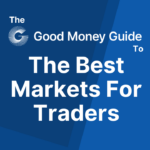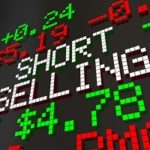Our how-to-trade forex guide contains the basic forex trading strategy you should know before trading the currency markets. We cover how to trade forex, what is forex trading if you can make money trading forex, some forex trading methods, executing forex trades and the main risks and rewards of trading foreign exchange.
- Want to trade forex? See our picks of the best forex trading platforms in the UK
Forex Trading Explained – Basic Strategy & Tips
You can trade forex in a variety of ways. The most common being
- Financial spread betting – betting on the price movement of currency pairs (unique to the UK)
- Forex CFDs – contracts for difference are an OTC trading product that mimics the underlying market where you enter into a contract based on the opening and closing price of a position.
- Futures trading – get direct market access to forex futures on the CME exchange
- Options trading – you can trade forex options either on exchange or OTC
- ETFS (exchange traded funds) – you can buy currency ETFs much like buying or selling shares
Basic Forex Trading Strategy
Calling the market right is not actually that hard when trading forex. What is hard is to find forex trading strategies that can consistently increase your profits and limit your losses. Here are three forex trading strategies that should help:
1. Forex Market Timing
This is a form of technical analysis and a fairly well established forex trading strategy for ensuring that your entry and exit prices are well-timed.
Once you have found a trade that you like the application of market timing and a chartist’s view can help you gauge whether or not a price is overbought, oversold, in trend or due a reversion. Investors Intelligence, FuturesTechs, and Acuity Trading all have good packages to help with this.
Technicals are tricky to trade though on unless you have a good and experienced eye for the market. Trading currency based on economic events that are either priced into or not price into the market is a good option though. Although with this you are not really trading currency, you are trading economic events, but using FX to try and profit from yoru predictions.
Read more about trading with technical analysis here.
2. Strategy discipline
Many traders enter into forex position correctly but fail to manage it appropriately once it is open. Discipline is a key factor in increasing profits and a lack of it is a massive contributor to excessive losses.
All traders should have a strategy of running profits and cutting losses.
If a trade is not going your way, close it out and look for the next opportunity. If you are showing a profit don’t be too eager to lock it in, a good trade can yield good spread betting profits. You can look to lock in some profits by using guaranteed stops and trailing stops offered by the top forex brokers as part of your risk mitigation strategy.
3. Economic figures and trading forex
Economic indicators as just as important for forex trading as they are for stock, index and commodities trading. For the simple reason that they move the market.
Before you enter any trade, part of your forex trading strategy should be to look for key upcoming economic data releases.
Most forex brokers provide a good economic diary on their website that shows who and what is reporting. The reason this should be part of your forex trading strategy is that if you enter a position based on technical and fundamental analysis then results or economic data are released it totally re-balances price.
It could result in an absolute change in direction and bear no relation to your entry strategy. Trading forex can be particularly tricky on the release of key economy data. Five set of economic figures you should watch out for include the following:
- GDP figures
- Unemployment rate
- Inflation figures
- Manufacturing/Services data
- Retail/Consumer spending
The key to trading forex around the release of these figures is the market’s reaction. If, say, the stock market reacted badly to a set of the GDP figures, it tells you something about the prior expectations. Too optimistic.
So you should definitely keep abreast of future economic data releases and plan accordingly. Note the market consensus. Read more on the top economic indicators to trade here
4. Technical analysis versus fundamental analysis for forex trading
Forex trading can be based on fundamentals or technical.
In general, the former use macro insights to produce buy and sell recommendations. The latter use prices only to determine entry and exit orders. Some may use both (hybrids).
Which is more effective?
It depends on two issues. The first one is, which system are you more compatible with? The second issue regards your ability to follow the method. Some traders eschew technical analysis because they believe technical analysis to be no better than random trading.
Meanwhile, many CTA funds have profited from using technical analysis methods exclusively. So the argument about which method is better is futile. The key is trader-strategy compatibility.
Read more on technical analysis versus fundamental analysis here
5. Managing risk when trading forex
When starting forex trading (or investing), the first rule to learn is that no one will be profitable 100% of the time. Even the greatest investor can’t achieve this feat.
What this means is that you will need to prepare for losses on a significant amount of the trades.
Losses can be separated into two types
- small recurring ones
- large devastating ones
To survive long term, you will need to avoid the latter totally.
Remember this rule of thumb: A 50% loss means the fund needs a 100% gain just to breakeven.
A 90% loss? You will need a 900% gain to return to the starting point! How often do you see this sort of gain?
How do you avoid large losses? One, do not bet too much on any single trade. Diversify into different pairs.
- Related guide: 50 rules for successful trading
Second, ensure small losses do not swell into large losses. Stop it every time. How? Use stop losses.
Swallow one’s ego and take the loss when they are small. When a trade is going against your way, it could last for a long time. Getting out is the preferred method. Some forex trading platforms offer guaranteed stop losses where the trade will be taken off once prices move adversely against you.
On small – but consecutive – losses, either you break trading altogether or lower position sizes. Small repeated losses can be demoralising because they can last for some time. Predicting when the tide will turn for that particular strategy is hardly possible.
Industry experts told us
"Forex trading is one of the most popular forms of financial trading globally. Foreign exchange rates affect almost all aspects of the financial markets and are so popular because of their deep liquidity and constant news from international economic events."What is Forex trading?
Forex is the short name for ‘foreign exchange’. It is a market about trading money. It is about measuring one money against another every other foreign currency. Forex trading is one of the largest financial markets in the world. Companies move capital across borders all the time, as do travellers, foreign workers, and governments. Billions of forex trading occur every 24 hours. There is a genuine need to exchange currencies.
Forex trading came about after the demise of Bretton Woods monetary system in early seventies. Before that, major currencies were based on gold. Now, most currencies fluctuate in value over time. Some drastically so. This is a characteristic of the fiat (ie, paper) monetary system. Once in a while, a central bank can even impose control on the value of its currency. The Swiss National Bank, for example, capped the value of the Swiss Franc in 2011 when the currency surged uncontrollably.
How does forex trading work?
Forex trading works by buying one currency against another and speculating on the price difference between the two. FX trading operates in all time zones five days a week; in all key financial centres like Tokyo, Singapore, Zurich, Frankfurt, London, New York. One exchange closes, the other opens.
Foreign exchange movements are relative. It is one value versus another, like a ratio. Most forex is priced relative to the US Dollar because of America’s outsized influence on world economy affairs, ie, the number of local currencies per US Dollar. When a FX rate is quoted without USD, it is called a ‘cross rate’.
Where can you trade Forex?
Forex is a 24-hour, 5-days a week market. Some brokers (like IG) even offer forex trading on the weekends. You can trade forex with CFDs futures, forwards, spread bets, or even exchange-traded funds (ETF). Because of this liquidity, there are forex trends that astute traders can exploit.
The best forex brokers are in the UK and are regulated by the FCA which means that they must adhere to a very strict set of rules when dealing with clients and marketing their services. All advertising must be balanced and fair. You’ll see lots of advertising from large brokers that offer forex trading through CFDs & Spread Betting. You can compare them here:
All of the above forex trading platforms only highlight their products – not how easy it is to make money. For whatever reasons you decide to trade Forex, “you pays your money, you takes your chance” – just make sure you use a regulated FOREX broker.
Is forex trading profitable?
The connectivity of the internet has democratised forex trading.
The proliferation of advance trading software gives retail forex traders tools that only professionals had in the past. You can execute automatic trading strategies (algo) forex markets, where buying and selling orders can be set up automatically.
You can trade currencies both ways – buy and sell – easily and leverage is easily obtainable from brokers.
Hence, the forex market is well suited to tech-savvy, independent thinkers. Interestingly, returns from the forex market can be largely independent to that of the stock markets. This is because factors influencing forex returns are different to that of stocks or bonds. There are periods when exchange rates are trending while stocks prices are static. Multi-asset funds are thus eager for these returns from the forex market because it helps to lower overall volatility.
There are also forex strategies that exploit interest rate differential. Broadly speaking, you first borrow from currencies with lower interest rates and then buy currencies with higher interest rates. This is known as the ‘carry trade’. During 2003-2006 it was popular to borrow in Japanese Yen and buy Pound Sterling because interest rates were low in Japan and high in the UK.
What forex pairs to trade?
For beginners (or even intermediate) traders, you should focus on key forex pairs that are liquid. This is because liquid FX pairs generally have lower bid-ask spreads. Also, these forex pairs are floating (most of the time anyway) and are not controlled by the central banks. The top five forex denominations are:
- USD-pairs
- EUR-pairs (Euro was born on January 1, 1999)
- GBP-pairs
- JPY-pairs
- CHF-pairs
This is followed by: CAD, AUD, SGD, CNY, MXN, among others. Countries with lots of commodity exports, such as Australia and Canada, are known as commodity currencies. The prices of commodities will impact their currencies to a certain degree.
You can read more on the most popular forex pairs for trading here
Types of forex orders
There are two main type of entry orders.
Market orders are ones that you wish to enter straightaway (‘market’) or at certain levels (‘limit’) and there are advantages and disadvantages in each selection
- Market orders ensure you are in the market quickly but your entry price may be subject to the prevailing conditions when you buy into it.
- Limite orders may give you better entry prices, but you may not execute the order. Prices may have simply run away.
Risks of forex trading
Trading forex is a risky activity. Harbour no doubts about this.
| Pros of forex trading | Cons of Forex trading |
| Potential for quick profits | Risk of large losses |
| Forex market open 24/5 | Hard to understand |
| Highly liquid market | Very volatile pricing |
Leverage
The first risk is leverage. Many retail accounts lose over time because of the overly high leverage. Minute, random price movements decimate accounts equity quickly if traders are caught on the wrong side. Small losses piled up. This can lead to early termination of the account.
Volatility
The second risk comes from sudden price moves.
For example, when the Swiss National Bank suddenly removed its cap in 2015 without prior warnings, it literally blew unrecoverable holes in many broker accounts because few traders expected the event. They were positioned in the wrong way – ie, the cap stays – and the removal of the cap led to huge moves in the opposite direction. Brexit was another such event.
Volatile price moves can lead to a dry-up in liquidity. Traders will experience in a huge increase in bid-ask spreads during these volatile periods, especially when brokers themselves are under stress.
Top tip: Check the forex market opening times for peak liquidity to reduce volatility
Counter-party risk
The third risk comes from brokers. Choose your broker well. Inferior ones lead to higher spreads and commissions, which encroach returns and add transaction costs.
Occasionally, forex brokers can go bust, leaving customer accounts in limbo. Find you if your broker is regulated or not and if customers funds are segregated. Another risk comes from inappropriate trading strategies for the market.
For example, trend-following strategies may be suited for some forex pairs; while reversionary strategies for better in other pairs. You will need to backtest strategies and conduct some dummy trading to ensure that the strategy you choose is viable for that particular forex market.
Other classic trading mistakes include:
- overtrading the account,
- undercapitalised funding,
- a lack of basic risk control,
- inability to shift strategies over time.
Alternatives to trading forex
Trading forex is hard and many new traders are lured into the world for currency speculation by social media influencers who are selling a lifestyle rather than any decent forex trading strategies.
If you’ve tried forex trading and not had much luck, here are a few alternatives that can help you scratch that trading itch, but come with the added benefit of being what I would call easier than betting on the price of currencies.
- Index trading – a bit easier because it’s based on the fundamental values of the companies it consists of. Also slightly less volatile.
- Commodities trading – pegged to a single commodity like Gold or Oil. Still good news flow, but very volatile
- Stock Trading – basically taking a bet on a single company – loads to choose from and with a huge amount of research available. The stocks in the top indices are the less volatile with the best liquidity.
- Fixed income investing for income – buying bonds and gilts to receive income from coupons – low risk and relatively low reward. Unless you buy junk bonds well below par in which case the risk and reward increase significantly.
- Dividend investing – buying shares with high dividend yields to receive income from the dividends. A bit riskier than bond investing, but there is capital upside (and downside) to consider.
- Options trading – you can trade options on almost anything. If you are buying you pay your premium and that is your max loss on the option (can be more if you are delivered on). If you are selling loses are unlimited so watch out.
- Cryptocurrency trading – the highest risk of trading as cryptocurrencies are about as volatile as they come with a price purely dependent on investor demand.
Forex Trading FAQ:
No, you cannot. Foreign exchange is one of the riskiest markets in the world to speculate on.
Yes you can, but you need a forex trading platform that offers DMA, or hedges your orders. Read our guide to scalping here.
Yes, it’s possible to make money trading forex. As with any financial market if you call the market right you can close profitable positions. However, speculating on the currency markets is very high risk and many traders do not make money.
Read our full guide on how to make money trading forex here.
Slippage is the difference in price between a take profit or stop order being triggered and the execution of the same. It can occur in fast or illiquid markets and comes about because stop and take profit orders are executed at the next available price in the market after they are triggered and FX prices can move significantly, even within a fraction of a second.
The only way to eliminate slippage is to trade with guaranteed stop losses, however, they usually have a cost attached to them and are not as flexible as a standard stop-loss order. To reduce potential exposure to slippage, it’s best to trade in the most liquid portions of the market in terms of both choice of instrument and times of the trading day.
We can also use limit orders to fix the price at which we are prepared to execute. Though of course, we have to weigh up when to use that order type and when it’s best to close a position, regardless of price.
The phrase Day Trading refers to a style of trading that carries no overnight positions; rather, day traders enter and exit a trade within the same business day. This serves two purposes: firstly, it eliminates overnight risk – that’s price changes and news flow that can happen while you are asleep – and secondly, it means that traders don’t incur any overnight financing charges or rollover swaps because their business is traded intraday.
Day trading is a very popular trading style but of course, it does limit a trader’s time horizons and tends to push them towards short-term swing and trend following trading strategies.
An FX day trader based in Europe might start their day by looking at what’s happened to the major FX pairs in the Asian session and for price movements that look likely to continue in European trading or indeed those that look like they’re running out of steam.
What might a day trade look like? Let’s imagine that the dollar-yen has changed overnight and the yen has continued to strengthen against the US dollar. Headlines in the European and overnight press suggest US rates will remain lower for longer and a dovish Fed Governor and board member is speaking later that day. In these circumstances, our imaginary day trader might well sell dollar-yen expecting the rate to fall further.
In the late afternoon, towards the end of the UK business day, the Fed board member speaks and intimates that interest rates in the US will stay lower for longer and the dollar-yen FX rates fall, allowing our day trader to close their short position for a profit.

With over 35 years of finance experience, Darren is a highly respected and knowledgeable industry expert. With an extensive career covering trading, sales, analytics and research, he has a vast knowledge covering every aspect of the financial markets.
During his career, Darren has acted for and advised major hedge funds and investment banks such as GLG, Thames River, Ruby Capital and CQS, Dresdner Kleinwort and HSBC.
In addition to the financial analysis and commentary he provides as an editor at GoodMoneyGuide.com, his work has been featured in publications including Fool.co.uk.
As well as extensive experience of writing financial commentary, he previously worked as a Market Research & Client Relationships Manager at Admiral Markets UK Ltd, before providing expert insights as a market analyst at Pepperstone.
Darren is an expert in areas like currency, CFDs, equities and derivatives and has authored over 260 guides on GoodMoneyGuide.com.
He has an aptitude for explaining trading concepts in a way that newcomers can understand, such as this guide to day trading Forex at Pepperstone.com
Darren has done interviews and analysis for companies like Queso, including an interview on technical trading levels.
A well known authority in the industry, he has provided interviews on Bloomberg (UK), CNBC (UK) Reuters (UK), Tiptv (UK), BNN (Canada) and Asharq Bloomberg Arabia.



